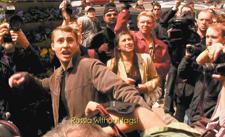Vancouver filmmaker Bob Christie’s new documentary, Beyond Gay: The Politics of Pride, is a timely reminder of the various struggles facing Pride organizers around the world. This film is particularly germane now as debates over free expression, international human rights and cultural sensitivity at Toronto’s Pride celebration rage on.
Over the course of a year, Christie follows Vancouver Pride Society president Ken Coolen to various international Pride events. At Warsaw Pride, a crowd of youths heckles marchers with “Great Poland, Catholic Poland.” In Budapest, marchers are separated from protesters by fencing that ultimately fails to prevent violence.
Perhaps the most moving sequence features a small but dedicated group of activists in Moscow, where Pride is banned. Christie shows how organizers lure police, press and anti-gay protestors to a decoy event at city hall while an actual 10-minute long, half-block, guerrilla Pride march unfolds without violence or arrest some distance away at the Tchaikovsky Conservatory.
“This was much more symbolic than getting beaten in the streets in front of city hall,” says Moscow Pride organizer Nickolai Alexeev in the film.
Alexeev declares victory when, after a gay man on the city hall decoy detail is violently assaulted on camera, police arrest the assailants and let the victim go free. The bruised and bandaged man appears later, all smiles, at a secret Pride afterparty.
In North America, Pride is complicated by an ever-encroaching commercialization and a sense that the festivals are turning away from their political roots toward tourism, party promotion and entertainment. Christie documents the ways larger, more mainstream Pride events have supported the global Pride movement. He shows how large celebrations employ controversial messaging even while collecting corporate and government sponsorship money.
In one lengthy sequence, former Pride Toronto executive director Fatima Amarshi describes the human rights components she added to the Toronto festivities during her tenure.
“We’re all very good at festivals,” Amarshi says. “We have a spot on the world stage. We can answer the call from Stonewall for an international civil rights movement.”
In the New York sequence, we meet the leaders of an alternative Pride parade, the Drag March, set up to protest the corporatization of New York Pride.
“Sometimes you have to take the parade back from the leaders in the community,” one marcher says.
“Those smaller Prides would in many cases love some corporate sponsorship,” Christie tells me over the phone from Mykonos. “In many ways, it’s a measure of how far we’ve come. I don’t blame Pride organizations for seeking sponsorship because their financial support helps provide the messaging that’s so important…. I was speaking to organizers from Croatia, and they said, ‘Just keep doing what you’re doing. We see that as inspiration, as hope.’”
That balance is perhaps best illustrated in the film by a sequence from Sao Paolo, the world’s largest Pride festival, where charged political messaging and corporate logos seem naturally to coexist. The festival’s slogan is “Homophobia Kills” and features an image of a beaten, fairy-winged man. The parade itself includes a completely empty float, meant to symbolize all those lost to HIV and violence. The crowd is huge, and authorities use tear gas to disperse it when it’s time to reopen the streets.


 Why you can trust Xtra
Why you can trust Xtra


